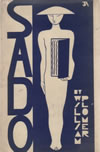
BJ. William Plomer
 |
5. Sado. London: Hogarth, 1931. Reprint, New York: Oxford UP, 1990.
Plomer’s novel set in Japan in the mid-twenties traces the relation between English painter Vincent Lucas and Sado Masaji, a Japanese university student, from a few days after Lucas’s arrival in the country until just before his departure the following autumn. That the work is largely autobiographical is clear from Plomer’s non-fiction accounts of the same period (especially in 10 and 15). The characterisation of Sado is recognisably drawn from Fukuzawa Morito (see 10c), and the work is the first in which Plomer directly addresses homosexuality. Includes beautifully-realised descriptions of the sights and scenes of Tokyo in the twenties, an evening in a geisha house on the Sumida, a picnic outing to a rural village, a summer festival, along with loving accounts of the ‘Japanese way of living’ and an ominous subtext of nationalism and patriotic arrogance. According to Alexander (40) Plomer began the work in Tokyo in 1929, but struggled with it, and eventually destroyed 50,000 words. Miner (A25), after discussing the exoticism of writing about Japan in the early years of the century, writes of Sado that ‘one is moved to sigh with relief, at last, over a realistic novel with a Japanese setting’. Reactions to the work by Virginia Woolf, Stephen Spender, and E. M. Forster are noted in Alexander. An American edition appeared under the title They Never Come Back (New York: Coward-McCann, 1932). See also 28a, 30, and 41.

